
Art in Alternative Spaces

Art in Alternative Spaces
presents
All The World's a Stage
Artists take a historical look at Chicago area theaters - both past and present -
and explore the theatrical journey from vaudeville stages,
through silent pictures to talking motion pictures
and full circle back to live performances once again.
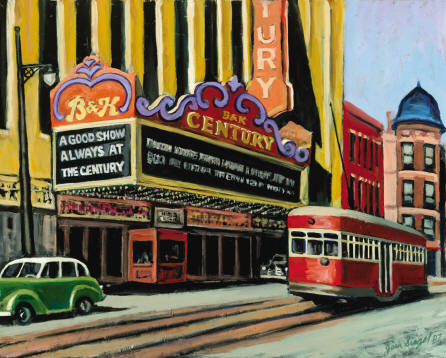
Artists:
Bruce Cutter, Don Elmi, Thomas Gessner, Bart Harris, Barbara Herring,
Howard A. Jacobs, Debra Paulson,
Russell Phillips, Bruce Sharp and Jack SiegelOn Exhibit at the
Paramount Arts Centre, Aurora, IL 60506
June 28 - July 26 2008!
Artists Reception: Saturday, July 19, 2008 (7:00 - 9:00 pm)
www.paramountarts.com
Archived Exhibition Photos Below
|
The Uptown Oil on
Canvas ©
Don Elmi
The Uptown Oil on Canvas © Don Elmi
The Uptown Oil on Canvas © Don Elmi |
The Esquire Oil on
Canvas ©
Don Elmi
Address:
58 E. Oak St. The Esquire was built and owned by
H&E Theaters, (the 'H' and 'E' being the two youngest brothers in the
Balaban family.) Elmer & Harry started their own theater
company, H and E Balaban Corporation and built a dozen or so theaters in
Illinois and Detroit. Their most famous theater was
the Esquire. The Esquire held the Chicago premiere of
Gone with the Wind. Sun-Times Article, May
11, 2007: REDEVELOPMENT | Owner alters
plans from small shops to 130-foot hotel; rezoning OK needed The owner of the shuttered
Esquire theater, 58 E. Oak, has changed plans for the property and now
plans to replace it with a 120-room hotel.
Zoning
documents filed with the city show that the owner, M Development LLC,
plans a building about 130 feet tall with the hotel and about 24,000
square feet of retail space. The site is on a stretch of Oak Street that
includes high-end shops. But it needs a zoning change to
proceed. When M Development closed the Esquire last September, its
principals said it wanted to replace it with a small building
exclusively for boutique stores, a project that would not have required
new zoning. The new request triggers a review by the city's
Planning and Zoning departments that could lead to a Chicago Plan
Commission hearing in a few weeks. Mark Hunt and Jeff
Shapack, principals at M Development, could not be reached.
Their firm
also plans a 20-story hotel at 1112 N. State, site of a four-story
building that dates from 1924. It's the old Cedar Hotel, and its terra
cotta facade is to be incorporated into the new design.
The Esquire was an example of an ornate movie house dating from
Hollywood's Golden Age of the 1930s, but in its last years it was
relegated to second-run films. The newer multiplexes got the best
bookings. The City Council turned down landmark status for
the theater in 1994.
|
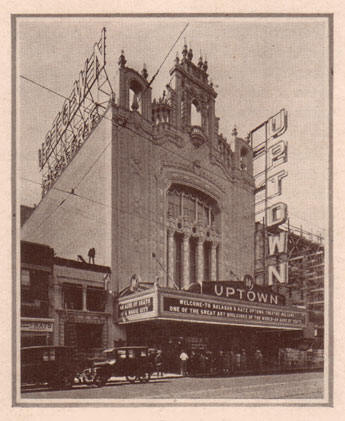 Photo courtesy of http://www.compassrose.org/uptowntheatre/history-intro.html
Address: 4816 N. Broadway The Uptown Theatre was built by architects
Rapp and Rapp for the Balaban and Katz Corp. This amazing corporation started as
a family business in the late nickelodeon era and by the early 1920s had control
of most film markets in Chicago. A financial analysis Balaban and Katz completed in 1923 suggested that
their best interests were served by building a theater as large and lavish as
they could manage near Broadway and Lawrence. And so, the Uptown was planned.
According to the press of the time, all of these buildings were built for
substantial cost and quality in order to be "for all time." When the Uptown
opened in August 1925, the phrase "an acre of seats in a magic city" was coined
to describe the wonders of over 4,300 seats in a theater that covered 46,000
square feet of land. At the time, it was the third largest in terms of seating.
But it was the largest, by far, in land area and cubic volume, due in part to
the three vast lobby areas. Many of the details we associate with a
movie palace had not been codified by the time the Uptown opened. The stage
shows were planned in consideration of the feature. Music was customized for the
large orchestra, as well as for the Uptown's Wurlitzer organ, the second largest
one in operation. Stars of national fame played regularly. Even the posters in
the display cases were custom artwork with new items every week. By the
end of the 1920s, after more than 20 million people had already attended the
Uptown. Some of the greatest theaters, such as Radio City Music Hall in New
York, were not even on the drawing boards yet. The American Broadcasting Corporation purchased the theater in 1969 and was subsequently operated as part of the Plitt Cinemas theater chain. The theater closed in 1981. Most of the damage to the building
occurred in the early 1980s, making it unusable without restoration.
Subsequently, even with the assistance primarily of volunteers, the building
remained in the hands of a notorious tax-sale buyer and continued to
deteriorate. In 1986, preservationists teamed up with
neighborhood activists to secure the addition of the Uptown to the National
Register of Historic Places. Several plans to restore the theater, perhaps as a
venue for concerts and other live performances, have been proposed, but none has
thus far moved beyond the planning stages. One recent restoration campaign
centered around an organization known as the Uptown Theatre and Center for the
Arts. Founded in 2001, the organization received the support of prominent
Chicago philanthropists, but suffered a major setback in April 2002, when the
Illinois attorney general's office charged its head with misappropriation of
funds.
A documentary film by John Pappas and Michael Bisberg was released in 2006 about the theater titled Uptown: Portrait of a Palace. The dvd is available for purchase or can be viewed for free by following this link www.nomadsland.com (click on the documentary button on their website to find the link to the film) To purchase directly from Compass Rose follow the link below: |
The Nortown, Chicago, IL
The
Nortown Oil on Canvas © Don Elmi
Address: 6320 N. Western Ave.
© Theater Historical Society of America (Brian Wolf)
© Theater Historical Society of America (Brian Wolf)
The Nortown was known for it sea horse, mermaid,
and zodiac motifs and featured a 3/15 Wurlitzer theater organ.
|
|
Don Elmi A self taught artist, Mr. Elmi worked as a freelance illustrator for most of his life and is known for his paintings of Chicago's historical buildings. Mr. Elmi also teaches painting to youths age 10 - 16 through Anatomically Correct. |
|
Chicago Theatre, Chicago, IL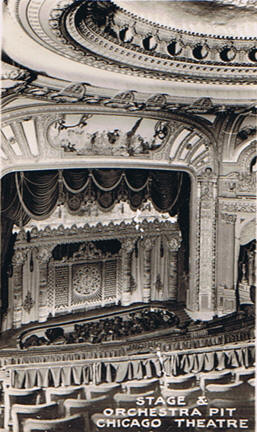
The grandeur of The Chicago Theatre often
leaves its visitors breathless. The elegant lobby, majestic staircase and
beautiful auditorium, complete with murals above the stage and on the ceiling,
are components of an amazing building called “the Wonder Theatre of the World”
when it opened on October 26, 1921.
Chicago Theatre Day and Night Oil on
Canvas © 2003
Don Elmi In 1986, Chicago Theatre Restoration Associates, with assistance from the City
of Chicago, bought and saved the theatre from demolition and began a meticulous
nine-month multi-million dollar restoration undertaken by Chicago architects
Daniel P. Coffey & Associates, Ltd. and interior design consultants A.T.
Heinsbergen & Co. of Los Angeles, interior design consultants. The Chicago
Theatre reopened on September 10, 1986 with a gala performance by Frank Sinatra.
|
|
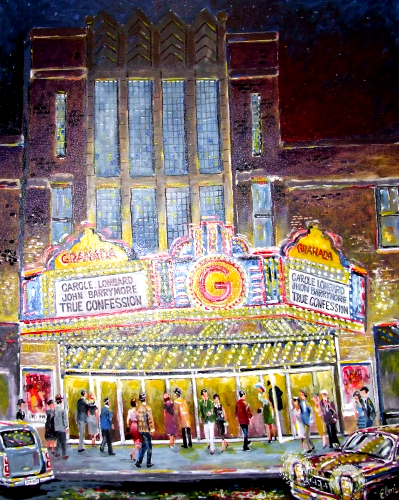 GRANADA
THEATRE GRANADA
THEATREAddress: 104 N. Ninth St, Mt. Vernon, IL Year Built: 1937 Architect: Boller Brothers The Granada, Mt. Vernon, IL Oil on Canvas © 2007 Don Elmi On December 14 - 17, 2007, the Granada Theater celebrated its Grand Re-Opening and 70th anniversary after an extensive renovation and held a marquee re-lighting ceremony. As part of the celebration, theater goers gathered to share memories, hear live musical and theatrical performances, and watch the first movie shown in the theater when it opened in 1937, True Confession starring Carole Lombard. The Granada is an Illinois Historic Landmark and after its 70th birthday (Dec. 2007), will be eligible to be listed as a National Historic Landmark. [Following is an excerpt from the Mt. Vernon Register News: Dec. 12, 2007 by Kandace McCoy]
|
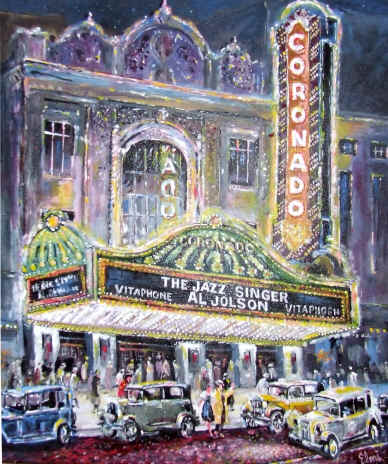 CORONADO
THEATRE CORONADO
THEATREAddress: 314 N. Main St., Rockford, IL. Year Built: 1926 Architect: Frederic Klein 1979: Listed on National Register of Historic Places 1980: Entered onto the State of Illinois Register of Historic Sites (one of only six in the state at that time). It is also listed as an historical landmark of the City of Rockford, Illinois. The Coronado opened on Oct. 9, 1927 as an atmospheric style theatre and movie palace - complete with Spanish castles, Italian villas, oriental dragons, starlit skies and a Grande Barton Pipe Organ. The name "Coronado" was chosen through a contest sponsored by the Rockford Register Gazette and Great States Theaters. On its first day of operation, the Coronado hosted 9,000 patrons during three showings of "Swim Girl Swim," a silent film starring Bebe Daniels. In 1927, Bob Hope appeared in "Roberta." In 1928, the theatre hosted legends of show business, the Marx Brothers. That same year, the Coronado showed its first "talkie," the Jazz Singer, starring Al Jolsen. In 1941, Gypsy Rose Lee scandalizes the community by appearing at the theatre, performing her striptease routine on Easter Sunday! Sammy Davis, Jr., Liberace, Tommy Dorsey, George Gershwin, Louis Armstrong, and Frank Sinatra all performed at the Coronado. The Coronado Oil on Canvas © 2003 Don Elmi In 1970, the Theatre was sold to the Kerasotes
Corporation. Upon finalizing the sale, George Kerasotes stated that the
acquisition of the "showplace of Rockford" by his group was a proud
event in his business career, because the Coronado had long been
recognized as one of the finest theatres in the nation. |
|
Devon Theatre, Chicago, IL
Address: 6225 N. Broadway The Devon was originally known as the Knickerbocker by the Lubliner & Trinz circuit. Located in Chicago's Edgewater neighborhood, the theater was later renamed the Devon (although it was more than two blocks away from Devon Avenue. It actually stood on Broadway.) Around the time it was renamed, the operation of the Devon was taken over by Essaness. It continued to operate through the 70' as a second-run movie theater, and later housed a church for a time. The Devon was demolished in 1996 after the block was acquired by Loyola University.
The Devon Oil on
Canvas © Don Elmi |
|
Village Theatre, Chicago, IL
Address: 1548-50 N. Clark St.
The Village, built as the Germania in 1916 but changed
to the Parkside after the US entry into the First World War when
anti-German sentiment was running high. The theater later went through a
couple of other name changes over the years including the Gold Coast and
the Globe. The theater is located on Clark Street at Germania Place in
the Old Town neighborhood of Chicago. Prior to being divided into
four small auditoriums in the early 90s, the theater could seat 900.
Little remains of the original interior design, but the facade, despite
being almost entirely hidden behind an ugly modern marquee, is still
intact and features red brick and beige terra-cotta highlights. The Village Oil on
Canvas © Don Elmi |
|
Address: 3733 N. Southport When it was opened in 1929, the Music Box
Theatre was considered tiny compared to its much larger, more palatial
neighbors. Many of these larger theaters, like the Uptown, were often
too large to stay in business throughout the rest of the 20th century.
The Music Box later played mainly second and third-run movies as well as
closing and reopening several times. By the 1970s, the
theater was showing Spanish and Arabic-language movies, as well as porn.
The theater had become more than a bit rough around the edges when it
was closed in 1977. The Music Box Oil on Canvas © Don Elmi |
|
Bruce Sharp Photography Bruce Sharp is the founder of the
Mekong Network and lives in a very old house in Chicago, with three
cats, two children, and one wife. He is currently the network
administrator for a software development company, and maintains the
Mekong Network websites in his spare time. His photographs
from Cambodia have appeared in several magazines and newspapers,
including the Washington Post. His photos appear in David Chandler's
biography of Pol Pot, Brother Number One, and on the cover of Richard
Lunn's book, Leaving Year Zero. He has been involved with
Cambodian issues since 1987, when he began tutoring refugees for the
Cambodian Association of Illinois, and for the Southeast Asia Center. |
|
|
Double-Sized Love Seat 400 Theater, March 1987 © Bruce Sharp |
Ladies Room Sign Sprague Theater, Elkhorn, WI , April 1987 © Bruce Sharp |
|
The Uptown Theatre, Chicago, IL
Uptown Exterior 1990 (left) and July, 2007 (Right) Note Parapet and Vertical Sign Removed © Bruce Sharp
|
|
|
Drinking Fountain Uptown Theatre, June 1990 © Bruce Sharp |
Facade Uptown Theatre, June 1990 © Bruce Sharp |
|
The Balcony is Closed Uptown Theatre, June 1990 © Bruce Sharp |
|
|
The Granada Theatre, Chicago, IL
The Granada (originally owned by the Marks Brothers) was of the Spanish baroque style and was considered the sister theater to the Marbro Theater (also owned by the Marks Brothers). The theater was known for its Giant Wurlitzer, 3,447 seats, and live theatrical productions. Balaban and Katz purchased the theater in 1929 and later sold to United Paramount ABC and then Plitt Theatres where it became a second-run movie house. The theater closed in 1975; however a promotional company rented it out for rock performances for a few more years. Following complaints from the neighborhood residents, the building was boarded up and sat vacant for many years. The property was sold for close to $1 million and torn down in 1989-1990. An apartment complex named the Granada Centre was built on the site. Granada Oil on Canvas (1989) © Don Elmi |
|
|
Lobby Granada Theatre, 1987 © Bruce Sharp |
Beginning of the End Granada Theatre, 1989 © Bruce Sharp |
|
Ceiling Detail Granada Theatre, 1989 © Bruce Sharp |
Setting Sun Granada Theatre, 1989 © Bruce Sharp |
|
Facing the Wrecker Granada Theatre, 1989 © Bruce Sharp |
Save Me Granada Theatre, October 1989 © Bruce Sharp |
|
Granada is Gone Granada Theatre, March 24, 1990 © Bruce Sharp |
|
|
The Nortown Theatre, Chicago, IL
Nortown Exteriors (Pakistani American Community Center) Nortown Theatre, June 23, 2007 © Bruce Sharp
|
|
|
Terra Cotta Detail Nortown Theatre, June 23, 2007 © Bruce Sharp
|
Auditorium Detail Nortown Theatre, June 23, 2007 © Bruce Sharp
|
 Demolition Nortown Theatre, June 23, 2007 © Bruce Sharp |
Nortown's Final Days Nortown Theatre, June 24, 2007 © Bruce Sharp
|
|
The Portage Theatre, Chicago, IL
Address: 4050 N. Milwaukee The historic Portage Park Theatre, located on the northwest side of Chicago, is the new home for The Silent Film Society of Chicago. Designed by architect Henry Newhouse, the theatre opened on December 11, 1920 with 1,938 seats as part of the Ascher Brothers theatre chain. Pre-dating the advent of America's movie palaces, the Portage Theater's megaphone-shaped auditorium features a formal beaux-arts opera house design. When the theatre was taken over by Balaban and Katz in 1940, its marquee, entrance lobby and foyer were redecorated in a sleek, streamlined art deco style to complement its new art deco neighbors -- the monolithic Sears department store and the five-story Klee Brothers building. In the 1980s, the theater underwent a dramatic change when a wall was constructed down the middle of the existing auditorium, resulting in two oddly-shaped cinemas. After a five-year period of darkness, the theater has reopened to its original shape, and has been refurbished and restored to its 1920's splendor.
Portage Facade Portage Theatre, 2007 © Bruce Sharp
The Portage © Don Elmi |
|
|
Auditorium Theatre, Outer Lobby, Chicago, IL
© 2007 Bart Harris
A postcard of the building circa 1900
Address: 50
E. Congress Parkway |
Fine Arts Building, Exterior, Chicago, IL
© 2006 Bart Harris
|
|
Bart Harris "I'm a native Chicagoan and a born
photographer, and have never wanted to be anything else. Funny thing is I've
been a pro since the age of 13 when I was commissioned by various friends'
parents to shoot portraits of their families. I had my first legitimate show at
17 and sold my first photographs to an ad agency at 18: race car photos for use
in Pure Oil national ads shot through Leo Burnett. I
started Bart Harris Photography, Inc. at 23 and shot retail fashion for Both
Marshall Field & Co. and Carson Pirie Scott & Co. as well as several small ad
agencies. Through the years I worked on many famous advertising campaigns such
as Virginia Slims, Walter Payton’s Wheaties Box, Michael Jordan for Gatorade,
Miller Light Beer’s sports celebrities (Dick Butkis, Marv Throneberry, Joe
Frazier and more), John Madden’s Ace Hardware campaign, Spuds MacKenzie for Bud
Light and many more. Eleven years ago, I became the first “people photographer”
in advertising to shoot 100% digitally. Shortly after this I began beta testing
for Eastman Kodak and advising various advertising agencies about technical
aspects of working with digital files. Bart recently photographed featured artists for the Chicago Artists Month 2006 brochure and is pursuing publishing a book of his photographs of Chicago's artists. |
|
|
The Palace, Chicago, IL
Inspired by the palaces of
Fontainebleau and Versailles, the theatre's distinctive
characteristics included a lobby richly appointed in huge
decorative mirrors and marble, which swept majestically
through a succession of lobbies and foyers; great wall
surfaces enhanced with gold leaf and wood decorations; and
2,500 plush, roomy seats. The theatre was
originally opened as the flagship of vaudeville's legendary
Orpheum Circuit, and among the stars believed to have played
the Palace in its early years are Jimmy Durante, Mae West,
Jack Benny, Sophie Tucker and Bob Hope. Despite
the popularity of such acts, audiences in the late 20's and
early 30's began to lose interest in vaudeville, and in 1931
the theatre was converted into a movie palace, initially
presenting films with live stage shows, and then eventually
showing only movies as the RKO circuit became popular.
When movie audiences began staying at home to watch
television in the 50's, the theatre managers, hoping to
attract larger audiences, booked occasional Broadway shows
into the theatre, such as "Gentlemen Prefer Blondes"
starring Carol Channing. During the late 1950s, the Palace
was fitted with special equipment to show films in Cinerama.
During the mid-1970s, the management of the Bismarck Hotel
transformed the auditorium into a banquet hall by removing
the seats on the orchestra level and bringing the floor
flush with the stage. In 1984, the theatre was
renamed the Bismarck Theatre and converted into a rock
venue. Sporadically used during the 90's, the
venue was completely restored and renovated during 1999, and
stands today as the renamed Cadillac Palace and is now home
to the successful major loop theater operation Broadway in
Chicago.
|
 Howard A. Jacobs A native Chicagoan, Howard (now 82), works in oils, acrylics, serigraphs, watercolors, inks and pencils. He also has created sculptures with Plexiglas. On commission, he creates renderings of homes and personalized notes and Xmas cards. His paintings hang in private homes, offices and restaurants in the United States and in Europe. After a WWII stint in the army, Jacobs attended the University of Illinois where he majored in architecture. He presently heads Howard Displays, Inc. designers and producers of industrial exhibits and commercial interiors. This image was drawn from Howard's childhood memories of the theater. The Palace 1930 22 x 28" Pen & Ink © Howard A. Jacobs
|
|
|
|
|
|
Magic Show 18 x 24" Watercolor © Howard A. Jacobs
|
Stage Show 18 x 24" Watercolor © Howard A. Jacobs
|
Glorious Past 24 x 30" Oil on Canvas © Howard A. Jacobs
|
|
The Century, Chicago, IL |
|
|
|
|
Jack Siegel "I went to the Century
in 1951 for the first time. That was about ten years after
the period depicted in the painting. I was overwhelmed by
the enormity of the space the height of the ceiling and
the grandiosity of the decorations. It was so typical of so
many of the Balaban and Katz movie palaces. The most lasting
impression was of the movie I happened to see that night a
full-length documentary of the Nazi Holocaust. So few people
were in the theatre audience watching it."
Jack Siegel, now 73, was born and raised on
Chicago’s West Side. He exhibited artistic talent and a
compulsive desire to draw and paint from an early age.
Jack graduated from The School of the Art Institute Of
Chicago, with a degree in drawing, painting and advertising
design. The Century Oil on Canvas © Jack Siegel
Randolph Street Oil on Canvas © Jack Siegel |
|
The Biograph, Chicago, IL |
|
Year Built: 1914 Architect: Samuel N. Crowen Date Designated a Chicago Landmark: March 28, 2001 The Biograph Theater is
one of Chicago's oldest remaining theaters. The
movie house was known for its historical connection to the infamous
gangster John Dillinger. John Dillinger was shot and killed
in 1934 after attending a screening of "Manhattan Melodrama" starring
Clark Gable (allegedly the ghost of Dillinger has haunted the theater
ever since). Biograph Oil on Canvas © Don Elmi
Photo: Liz Lauren, courtesy Victory Gardens Theater |
|
The Coronet, Evanston, IL |
|
Address:
817 Chicago Ave., Evanston, IL
Year Built: 1915
Architect: Unknown
In the 50's and 60's the theater was known for its foreign and art films. In the 70's it served as a first-run movie theater. From 1990-1994, the theater was the home to Northlight Theatre Co. (now located in Skokie, IL) It was torn down in 2000. A condominium building stands in its place.
Coronet Oil on Canvas
© Don Elmi
|
|
The Paradise, Chicago, IL |
 Address: 231 N. Pulaski Rd., Chicago, IL
Address: 231 N. Pulaski Rd., Chicago, ILYear Built: 1928 Architect: John Eberson Status: Demolished The Paradise Theater was built in the Garfield Park neighborhood of Chicago. In 1956, the Balaban and Katz chain demolished the theater. The theatre was immortalized in 1981 when
the rock band Styx recorded its album Paradise Theatre.
|
|
The Paramount, Aurora, IL |
 Address: 23 East Galena
Boulevard, Aurora, IL
Address: 23 East Galena
Boulevard, Aurora, IL Year Built: 1931 Architect: C.W. and George L. Rapp The venetian style theater was commissioned by theater owner J.J. Rubens who, before construction, sold the company to the Paramount Famous Lasky Corporation. When Paramount Pictures owned the design, they decided to build movie palaces all over the country, using this theatre as a prototype. The first movie that played at the Paramount was "Secrets of a Secretary" starring Claudette Colbert. The first live appearance was Groucho Marx. For more than 40 years, the Paramount offered the public a variety of entertainment, including "talking pictures", vaudeville, concerts and circus performances. In 1976, Aurora Civic Center Authority purchased the Paramount and closed the theater for restoration. The $1.5 million project restored the Paramount to its original grandeur. On April 29, 1978, the Paramount Arts Center opened, offering a variety of theatrical, musical, comedy, dance and family programming. In 2006, a 12,000 square foot lobby was added. The Grand Gallery houses a state-of-the-art box office, a cafe, a gift shop and an art gallery. The renovation of 28 Downer has provided a home for the Paramount School of Performing Arts bringing professional acting classes to the western suburbs. Today, the Paramount Theatre supports an annual audience of 150,000 patrons and was named one of the Top 10 theatres in Chicago by the League of Chicago Theatres. The theatre continues to be an anchor in the city bringing in approximately $3.3 million in ancillary revenue as well as hosting many free community events including the Midwest Literary Festival, the Air Force Band Concert, the Aurora Idol Competition and staging the annual Fox Valley Park District children’s production.
Paramount Oil on Canvas
© Don Elmi |
|
Rialto Square Theatre, Joliet, IL |
|||
|
Address: 102
N. Chicago St.
Once home to many important vaudeville performers, the Rialto Square Theatre continued live performances until it was sold in 1968 and subsequently turned into a movie house. The building continued to serve as a movie house into the late 70's, but as the downtown area of Joliet grew tired and "out of style", the building was soon on the "chopping block". In 1978, a campaign to "Save the Rialto" for future generations as a performing arts center was initiated by local piano instructor Dorothy Mavrich, president of the Rialto Square Arts Association - now the Cultural Arts Council of the Joliet Area. "Save the Rialto" involved the entire community. With the assistance of local businessman, Christo Dragatsis, support was sought from city, state and federal officials. Former State Representative, LeRoy Van Duyne, was instrumental in obtaining the necessary funds for purchase of the properties.Listed on the National Register of Historic Places, the Rialto is a not-for-profit organization under the direction of the Rialto Square Theatre Corporation. The Will County Metropolitan Exposition and Auditorium Authority heads the Rialto Square properties.
Rialto Ushers circa 1926.
During the 20's , the "golden voiced" Barton Grande Theatre Pipe Organ accompanied silent movies and vaudeville with its variety of sounds and sound effects. Today, it continues to be a popular attraction as well as a historic treasure. The Joliet Area Theatre Organ Enthusiasts have provided its care and maintenance as a labor of love since 1972.
|
|||
|
|
|
|
|
|
The Rialto, Joliet, IL Exterior Facade © 2007 Debra Paulson |
The Rialto, Joliet, IL Exterior Facade © 2007 Debra Paulson |
The Rialto, Joliet, IL Front Entrance, Box Office © 2007 Debra Paulson |
The Rialto, Joliet, IL View from Above © 2007 Debra Paulson |
 |
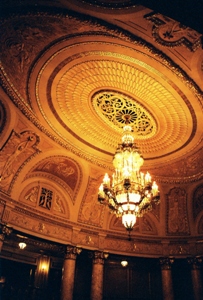 |
 |
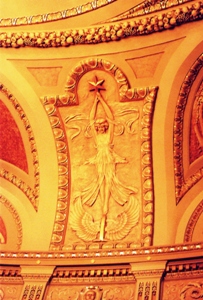 |
|
The Rialto, Joliet, IL Fountain © 2007 Debra Paulson |
The Rialto, Joliet, IL A Look Above © 2007 Debra Paulson |
The Rialto, Joliet, IL Detailed Carving © 2007 Debra Paulson |
The Rialto, Joliet, IL Detailed Carving © 2007 Debra Paulson |
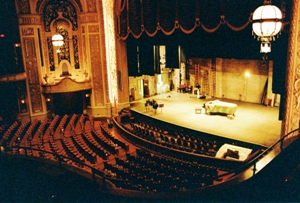 |
 |
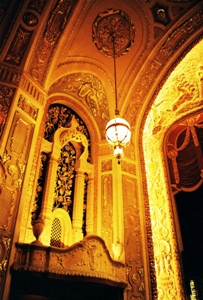 |
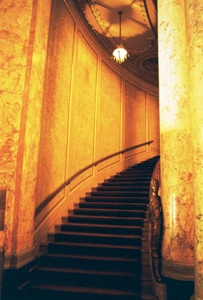 |
|
The Rialto, Joliet, IL Inside Theater © 2007 Debra Paulson |
The Rialto, Joliet, IL Stage Curtain © 2007 Debra Paulson |
The Rialto, Joliet, IL Box Seats © 2007 Debra Paulson |
The Rialto, Joliet, IL Staircase © 2007 Debra Paulson |
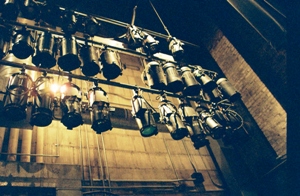 |
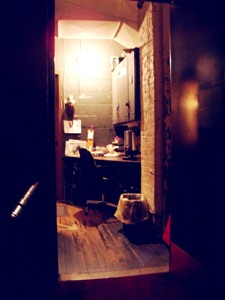 |
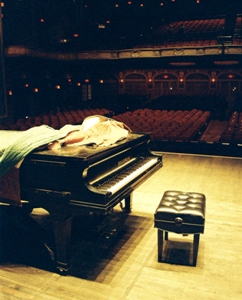 |
 |
|
The Rialto, Joliet, IL Stage Lights © 2007 Debra Paulson |
The Rialto, Joliet, IL Stage Manager's Office © 2007 Debra Paulson |
The Rialto, Joliet, IL Piano, View from Stage © 2007 Debra Paulson |
The Rialto, Joliet, IL Piano on Stage © 2007 Debra Paulson |
|
Live Performance: Vaudevillian Debra Paulson "I'm a photographer born and raised in the City of Chicago, a living architectural museum - every conceivable style of architecture is on display here in the 'Second City'. With that as my inspiration I set out to isolate the elegant, repetitive patterns found within the facades and interiors of Chicago architecture and public art, inviting the viewer to take a second look at these innovative structures. When the opportunity arose to photograph the restored Rialto Square Theatre in Joliet, Illinois how could I resist? Listed on the National Register of Historic Places, the Rialto’s sumptuousness is evident everywhere – from the welcoming marquis and ornate box office that entice visitors to enter to the detailed overhead lighting fixtures and carved and guilded woodwork. Entering this elegant theatre was like taking a step back into a bygone era and it was a privilege to capture it on film."
Debra shot these photos during a group outing where 44 other
artists were invited to tour the Rialto and create art on the spot en plein
air style. Her photographs have been exhibited at Woman
Made Gallery, the Illinois Institute of Art, and ARC Gallery to list just a few.
She is also known for her pet portraits.
|
|||
|
Rialto Square Theatre, Joliet, IL
Inside the Rialto 6 x 12" Oil on Canvas © 2007 Barbara Herring Rialto Lobby 6 x 12" Oil on Canvas © 2007 Barbara Herring |
|
Barbara Herring "I am a Chicago based
artist currently affiliated with the Chicago Artists Coalition and the
Palette and Chisel Academy of Art. My skills were
developed in private studies at the historic Tree Studios in Chicago and
the Drawing Workshop with George Sotos. Currently, I am part
of the plein air group that paints in Chicago neighborhoods every
Saturday Morning. Barbara is a member of the Plein Air Painters of Chicago. She created these paintings during a group outing where 44 other artists were invited to tour the Rialto and create art on the spot. |
|
The Varsity |
Year Built: 1926 Architects: John E.O. Pridmore Status: Converted to Retail Space The Varsity Theater was the largest and most
lavish of all the suburban Chicago movie palaces. Its
original owner, Clyde Elliot was from Evanston and worked in Hollywood for
several years. The Varsity Oil on Canvas © Don Elmi
Photo Courtesy of EvanstonNow.com |
|
RUSSELL B. PHILLIPS "The interior views in this collection represent movie theaters from the 1920’s and 30’s. As an American architectural development its uniqueness can be attributed to the film production it presented and the audience it sought to entertain. In its hey day the masses were escaping into a fantasy of Persian courts, Egyptian temples, seafaring towns with mermaids and seahorses, or Aztec and Mayan ruins. These houses of fantasy were scattered throughout our cities and could be found in every small town. They were as abundant as houses of worship and often regarded with equal stature. George L. Rapp , one of Chicago’s prominent theater architects, believed the movie house was a "shrine to democracy...where the wealthy rub elbows with the poor.." As much as I respect the historic value of the vintage movie theater, my initial attraction was not to just document for preservation. As well, I have an interest in how the application of color defines our perceptions of place. My response of fascination and seduction to these interiors is not unlike that of its original audience. There is an uninhibited use of color and ornamentation that reflects an age of optimism. The inclusion of vending machines, candy counters and posters, all of which have their own vintage place and chromogentic ambitions, contribute to this seductive atmosphere of fantasy. These images are a result of four years of perusing all theaters that would provide me access. They are all in the Chicago area, many having been razed, abandoned, or split up into smaller spaces. All images are exposed on to 4x5 color transparency film, scanned and printed on an Epson 7600 with Ultrachrome Ink." Mr. Phillips received a BFA from K ansas City Art Institute and a MS from the Illinois Institute of Technology, Institute of Design. His photographs have been exhibited at the Chicago Cultural Center, the Chicago Historical Society, the International Photography Hall of Fame in Oklahoma City, OK and the Illinois State Museum, the Water Tower Gallery and O'Hare Airport in Chicago to list just a few. |
|
|
|
|
|
Nortown Theatre Auditorium, Ink Jet Print (Photo no longer available for purchase) |
Nortown Theatre Staircase, Ink Jet Print (Photo no longer available for purchase) |
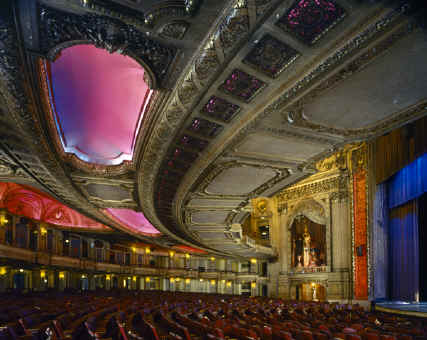 |
|
|
Chicago Theatre Auditorium - Main Floor, Ink Jet Print (Photo no longer available for purchase) |
Chicago Theatre Grand Staircase, Ink Jet Print (Photo no longer available for purchase) |
|
|
|
|
Pickwick Theatre Exterior, Ink Jet Print (Photo no longer available for purchase) |
Music Box Theatre Lobby, Ink Jet Print (Photo no longer available for purchase) |
|
|
|
|
United Artist Theatre, Detail, Ink Jet Print (Photo no longer available for purchase) |
Oriental Theatre Lobby, Ink Jet Print (Photo no longer available for purchase) |
|
|
|
|
Coronado Theatre, Upper Lobby, Ink Jet Print (Photo no longer available for purchase) |
Coronado Theatre, Auditorium, Ink Jet Print (Photo no longer available for purchase) |
|
|
|
|
Paramount Theatre, Auditorium, Ink Jet Print (Photo no longer available for purchase) |
DuPage Theatre, Auditorium, Ink Jet Print (Photo no longer available for purchase) |
|
Thomas Gessner Pen & Ink Drawings (Available in 8 x 10" Prints and 5 x 8" Notecards) Trained in architectural drawing, Thomas has always been interested in historical preservation and landmark buildings. Thomas has created a large collection of pen & ink drawings of numerous historic theatres across the country. He is also a member of the Theatre Historical Society of America. Thomas was born and raised in Rockford, IL.
|
||
|
|
|
|
|
The Pickwick © Thomas Gessner Address: 5 S. Prospect Ave, Park
Ridge, IL This art deco style theatre was designed as a vaudeville and movie house. Falling in to disrepair in the late 70's, it was forced to shut down due to code violations. In 1981, the theater was renovated by the Vlahakis family. From 1991 - 1994, three smaller screens were added to the rear of the theater, however the theater's original 40-foot screen was preserved. The theater's facade was used as the backdrop for the opening sequence of Siskel and Ebert's At the Movies. Currently, the theater shows first run movies. |
The Music Box © Thomas Gessner
See Above Description |
The Tivoli © Thomas Gessner Address: 5021 Highland Ave,
Downers Grove, IL Year Built: 1928 Operated for its first 20 years by the Balaban and Katz Corp., it was only the second theatre in the U.S. designed to play "sound" movies. Known as the "wonder theatre of the western suburbs" the theater used Vitaphone and Movietone sound systems. A typical show featured a talking picture, talking and singing acts, and a Movietone news reel. In the 1950's, a CinemaScope screen was added in front of the proscenium arch covering its architecture and preventing the use of the stage.
The theatre's original marquee was
removed in the 1960's and replaced with a "modern" one. The parpet
was also removed.
Today the theater is home to the
Midwest Ballet Theatre and continues to show films and host live
performances and plays. |
|
|
|
|
|
The Coronado © Thomas Gessner Address: 314 N. Main St.,
Rockford, IL. |
Chicago Theatre © Thomas Gessner
See Above Description
|
|
|
Bruce Cutter Bruce works professionally as a
graphic designer. He holds degrees in both theatre and
graphic design. He has an interest in the architecture and
history of classic theatres and movie houses. He
frequently travels the country to tour and photograph the buildings and
marquees that have survived the years and are in current danger of
disappearing forever. More of Bruce's theatre images can
be found at |
|
|
|
|
|
Esquire, Color Photography |
Paramount, Color Photography |
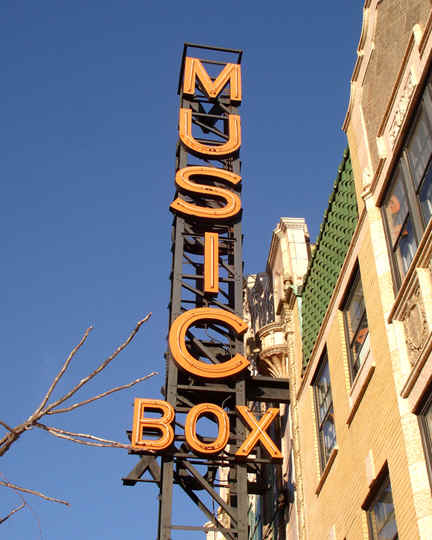 |
|
|
Music Box, Color Photography |
Geneva, Color Photography |
|
|
|
|
Midway, Rockford, IL, Color Photography |
Times, Rockford, IL, Color Photography |
RIP's: Tivoli (Chicago) - 1963; Marbro - 1964; Regal Theater - 1968; Century (Diversey) 1973 - McVickers - 1985; Sheridan Theatre - 1989; United Artists Theatre (formerly Apollo, now Chicago's "Block 37") - 1989; Commodore Theatre - 1990; Granada Theatre - 1990; Rhodes Theatre - 1990; Belmont Theatre - 1991; Southtown Theatre - 1991; Devon Theatre - 1996; Coronet Theatre (Evanston) - 2000; Adelphi Theatre (later North Shore Cinema) - Feb. 2006; Esquire - 2006; Three Penny - 2007; Village Theatre - 2007; Nortown - 2007; DuPage Theatre (Lombard, IL) - 2007.
Joe DuciBella - June 29, 2007 - Theater historian and founder of Theatre Historical Society of America. He led the renovations of two of Classic Cinemas' most historic theatres, the Tivoli Theatre, in Downers Grove, IL, and the Lake Theatre, Oak Park, IL. Joe worked for B&K in many of its theatres, including the Marbro and Uptown theatres. The Chicago Theatre was saved with his help and he was active as a volunteer in the continuing "Friends of the Uptown" effort since 1979 – even before the theatre closed to the public.
Theatres in jeopardy: Uptown , The Gateway, and The Patio
Resources: Please Note; Anatomically Correct does not endorse sites behind external links.
www.historictheatres.org (Theater Historical Society of America)
A Theater of Our Own: A History and a Memoir of 1,001 Nights in Chicago, Richard Christiansen © 2004, Northwestern University Press, Evanston, IL
The Chicago Movie Palaces of Balaban and Katz, David Balaban © 2006 Arcadia Publishing, Chicago, IL
www.balabanandkatzfoundation.com
© 2019 Anatomically Correct. No text or photograph contained in the pages of this website may be reproduced without the expressed written permission of the artist and/or Anatomically Correct.
Founded in 1991, Anatomically Correct is a not-for-profit organization dedicated to showcasing works by artists in alternative spaces in a combined effort to educate, diversify, and promote community awareness of the visual and performing arts. This project is sponsored in part by the Chicago Dept. of Cultural Affairs Program I grant, the Illinois Arts Council, a state agency.
For more information or to purchase artwork, please
contact:
Anatomically Correct